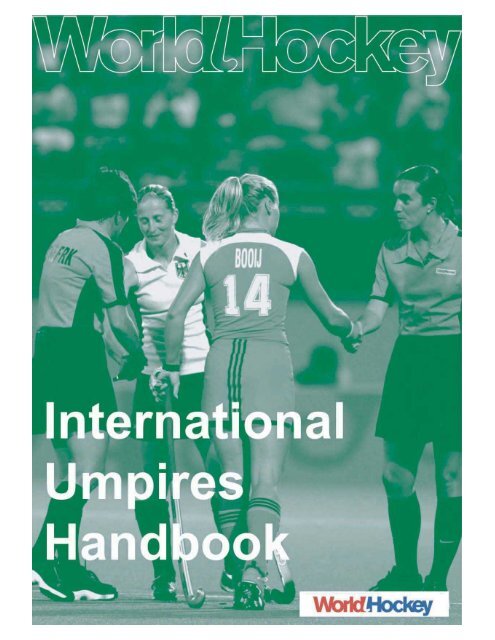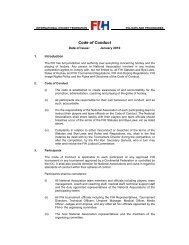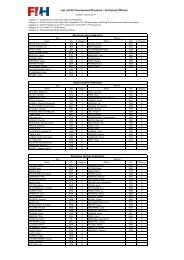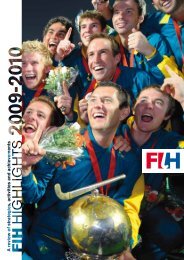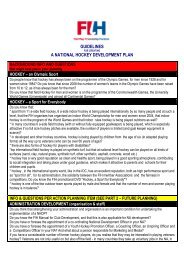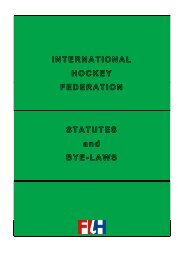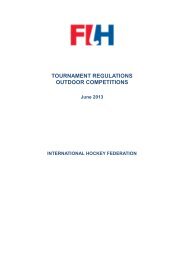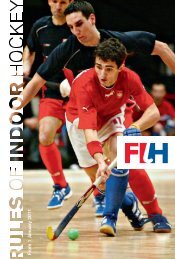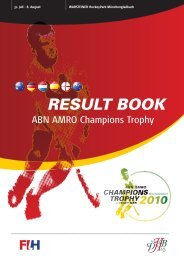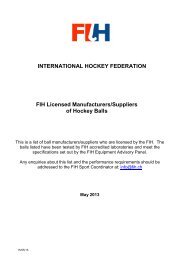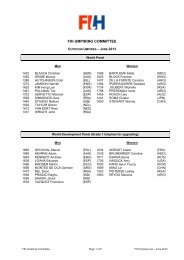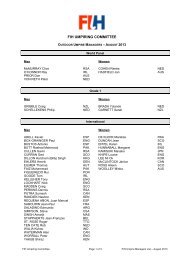Umpire's Handbook - International Hockey Federation
Umpire's Handbook - International Hockey Federation
Umpire's Handbook - International Hockey Federation
Create successful ePaper yourself
Turn your PDF publications into a flip-book with our unique Google optimized e-Paper software.
INTERNATIONAL UMPIRES HANDBOOK 2005 10. At a tournament the Tournament Director is responsible for appointing umpires tomatches, and this will normally be done in liaison with the Umpires’ Manager if onehas been appointed. Either the Tournament Director or the Umpires Manager willgive you detailed information as to how the formalities at a tournament are to behandled.11. The role of the Umpires’ Manager (there is one appointed when there are morethan four teams at a tournament) is to help you improve your performance throughcoaching, and to ensure that other arrangements with hotel, transport etc. gosmoothly. They work closely with the Tournament Director, Organising Committeeand other technical officials to help develop the umpiring team.12. Increasingly, video is being used to analyse an umpire’s performance, and youshould be prepared to be involved in such a review session following yourmatches.13. At the end of a tournament, you should have a review meeting with theTournament Director and Umpires’ Manager. You will receive at the end of theevent, a written feedback report, which should cover those matters discussed withyou.14. The Tournament Director is responsible for marking your umpiring performance.The Umpires’ Manager also submits a report on the overall operation of thetournament from an umpire’s perspective. The FIH Umpiring Committee isresponsible for decisions on your grading and future progress, based upon thereceived marks and reported performances.The Rules Governing the Grading of <strong>International</strong> Umpires are available on theFIH website, and are normally updated on a yearly basis.15. As part of the award of ‘<strong>International</strong> Umpire’ status you will receive a badge, smallsilver coloured whistle as a lapel badge and an ID card with photograph. Since1998 being a holder of this ID card no longer entitles you to free admission to anyevent.A lapel gold coloured whistle is awarded to all those who achieve 100 officialSenior Inter-Nations matches.16. Ensure you notify the FIH promptly of any change in your contact details. E-mailshould be used wherever possible.17. Allowable matches in relation to <strong>International</strong> Umpire ‘Caps’:(i)(ii)(iii)Any Senior/U-21 Outdoor Inter-Nations matches played in a tournamentapproved by the FIH and controlled by a Tournament Director.Any Senior/U-21 Outdoor single Inter-Nations match for which the FIH hasreceived an ‘A’ Team Result Match Form.Any match that is not registered as described above will not count as far asan umpiring "cap" is concerned. It is important therefore that where everpossible National Associations are encouraged to register a match. Thereare no longer any fees applicable for such match registrations.
INTERNATIONAL UMPIRES HANDBOOK 2005 3. Travel Hints1. Check well in advance of your travel whether or not you need a visa and/or anymedical injections. It is your personal responsibility to obtain these, although yourNational Association may be able to assist.2. Prepare yourself by gathering information about the country you are visiting; forexample about food, local culture and customs, currency and weather conditions.3. Carry some local currency in case of unforeseen expenses.4. Carry in your hand luggage your hotel details, a copy of your invitation and otheressential tournament paperwork and information. Also carry any other personalitems that would be a problem if your other luggage is either delayed or lost.5. Take with you any medications or toiletries, since these may be difficult to acquire.6. Check that you are fully insured. You are generally covered by the FIH InsurancePolicy in the case of an FIH appointment. This should be notified to you at the timeof your appointment, but even then ensure that the cover provided is enough foryour personal needs.7. Always take dress suitable for a formal occasion. Most tournaments usually haveat least one official function.8. If you are travelling across several time zones, try and get your body used to localtime as soon as possible. If you have had a long flight, do not go straight to bedunless local time is night.In-flightWear loose fitting clothing and footwearTake books, personal stereoDrink plenty of fluids, water, fruit juices or cordials. Avoid too much alcohol anddrinks containing caffeine such as tea and coffee.Do regular stretching exercises and walk up and down the cabin aisle.On arrivalTake some light exercise e.g. walking or stretchingDrink extra fluids, again water or fruit juicesUndertake light training only.
INTERNATIONAL UMPIRES HANDBOOK 2005 4. Check List for Tournament Preparation1. Start your fitness programme early and build up to the tournament. You need to beconfident in your ability to pass a fitness test2. Discuss with senior umpires / national team coaches playing styles that you mayexperience. Where possible, use videos of international hockey to get an impression ofwhat to expect. This is very important for your preparation as some of the games areoften far quicker than national hockey.3. Be aware that your training should be appropriate to the weather conditions in thecountry you are visiting, and make any necessary adjustments accordingly.4. Make sure you are match fit by regularly umpiring appropriate standard matches in theweeks leading up to your event.5. To improve your understanding of playing styles and techniques as well as improvingyour understanding of tactics, it is recommended that where possible you attendnational team training sessions or top club training sessions. You will also find this willhelp you to develop your management skills and rapport with the players.6. Make sure you re-read the current <strong>International</strong> Rules book, are aware of currentinterpretations and have read any relevant Tournament Regulations.7. Role of Neutral Umpire or experienced umpire(i)At events where there is no UM appointed the TD may ask you to take on therole of 'Umpires’ Team Captain'. The TD should announce this to the umpiresgroup and will explain what they wish you to do. This will normally involveacting as a link between the TD and other umpires and possibly some'coaching' of the less experienced umpires. Be aware that this role is not anobligation, and that it should not be allowed to adversely affect your ownumpiring performance.Even if the TD does not ask you to become 'Team Captain' as the NeutralUmpire you may well find that the less experienced umpires look to you forpractical advice.(ii)At smaller events you may find that the TD decides to give fewer appointmentsto you and more to less experienced umpires. The TD will normally explain thisto you. This is a good way of providing development opportunities for newumpires.These are just some of the responsibilities that come with being a ‘neutral’ or anexperienced umpire. Remember the kind of help that you would have liked at your firstTournaments!
INTERNATIONAL UMPIRES HANDBOOK 2005 5. Check List for Mental SkillsPre- Match / Tournament• Relaxation• General Preparation - am I fully prepared?• Personal checklist of things to 'do'• Positive mental rehearsal - past games, upcoming games, pressure situations,stadium, crowd, player's etc.• Check rules / tournament regulations• Positive self reassurance• Stretching• Hydration & Diet• Establish a 'Plan B' if something goes wrong• Pre-match discussion - where umpiring with an unknown colleague a short checklist may help communication.During the match• Concentration - use visual, verbal cues to refocus• Momentary relaxation during appropriate breaks in play - deep breaths• Problems and emotions - gain 'time' to manage the situation• Enjoy the game - use your refocusing skills to focus on players / fun• Personal injury - have the courage to go off - develop a strategy for the right timeto call for a replacementPost Match / Tournament• Self analysis• Feedback – umpires’ manager / players/ coaches - develop a feel for who you cantrust to the objective• Checkout more than one source of feedback• Critical assessment / Positive assessment• Cut - off assessment and analysis stops and looks forward to next game• Visualise game• Video
INTERNATIONAL UMPIRES HANDBOOK 2005 7. Medical1. A full medical check up including EKG (ECG) cardiovascular status2. Blood Analysis3. Urine AnalysisIt is further recommended that at least once every year you have:1. An eye sight test2. A hearing examinationYour National Association should be able to arrange / facilitate these tests / examinationsfor you. It is nevertheless still your personal responsibility to take care of your health andarrange for the necessary tests / examinations.
INTERNATIONAL UMPIRES HANDBOOK 2005 9. ConclusionIn this handbook we have attempted to give you information which should assist you toproperly prepare for your tournaments, and help you to deliver good umpiringperformances.It is vital for you to develop a good understanding, both verbal and written, of English. Allof the FIH Briefings and discussions are given in English. The higher up the umpiringladder you rise, the more important it is that fully understand the language of <strong>Hockey</strong>. Alack of proper understanding may hinder your umpiring development, or certainly makeyour career progress more difficult than it might otherwise have been.Please note that the section on Technical Skills, which was included in the last version ofthe <strong>International</strong> Umpires <strong>Handbook</strong>, since 2004 has effectively been covered in theUmpiring section of the Rules of <strong>Hockey</strong> booklets. This should be read as if it is still partof this <strong>Handbook</strong>.Peter von RethChairmanFIH Umpiring CommitteeE-mail: vonreth@iae.nlAcknowledgements, based upon the original 2001 version: Jane Nockolds, JackieDabinett, Chris Harwood, Dennis Meredith, Corinne Pritchard, Hamish Jamson, DaveClark and Loughborough University.
INTERNATIONAL UMPIRES HANDBOOK 2005 Appendix 1.Mental PreparationA strong relationship exists between the psychological skills and the physical performanceof umpires. Indeed, the success or failure of an umpire depends on his or her physicalability (i.e. conditioning for the demands of hockey, techniques, visual skills) and mentalability (i.e. confidence, concentration, emotional control).Just as physical skills can be learned, so can psychological skills. Effective umpires arenot born with a complete set of psychological skills. Their ability to concentrate, relaxunder pressure, maintain confidence and relate to players and officials is systematicallyand repeatedly practised.In order to develop psychological skills (become better mentally prepared) a number ofkey elements need to be considered:• Communication• Confidence• Concentration• Motivation• Relaxation• Mental Imagery.1. CommunicationAn umpire who has a pleasant style, quick smile and calm demeanour creates a moresoothing effect on players and coaches. Communication is a two-day business; keepthe lines of communication open and you will be more likely to have constructive andenjoyable relationships with players, coaches and spectators.2. ConfidenceResearch indicates that confidence is the one factor that separates highly successfulumpires from less successful umpires. Confident umpires believe in themselves andtheir ability to meet the challenges and decisions they face during a match. Theyhave a high expectancy of success. However, it is worth noting that regrettably, manyumpires are either over-confident or under-confident. It should be noted thatconfidence alone does not overcome incompetence.3. ConcentrationAlthough it would seem relatively easy to focus on the action in the game, inevitably awide variety of irrelevant interruptions compete for an umpire’s attention. These mayinclude a hostile group of spectators, poor weather conditions, a particularly vociferouscoach, etc.Umpires are advised to try to keep the mind free of the distractions around them andfocus their attention on the action. In preparing to concentrate they must learn:• to cope effectively with pressure and anxiety;• to selectively attend to relevant areas while ignoring irrelevant areas(distraction).• to rapidly re-focus attention on the immediate task if distracted.
INTERNATIONAL UMPIRES HANDBOOK 2005 • to properly apply the Rules, mechanics and positioning in order to umpireeffectively.4. MotivationStaying motivated is not always easy. Today’s hockey umpire is exposed toincreasing pressure. We umpires therefore need to sustain our motivation.One effective way to do this is through goal-setting. When correctly set, goals canbe tremendously effective tools for increasing motivation and improving performance.All goals should be within the control of the umpire and reflect improvements based onpersonal standards of excellence.In addition to goals, such things as finding inspiration in role models, rewardingyourself, and maintaining your personal love of the sport and umpiring will help anumpire maintain his or her commitment.5. RelaxationThere are a variety of relaxation techniques that can assist umpires.Physical techniques include:• progressive relaxation (tense all muscles and progressively relax themgradually).• breath control (breathe out strongly attempting to exhale all the air from thelungs, then breathe in and hold the breath for a count of 8. Exhale the air gently.Wait for a count of 5 and check to see if the finger-tips tingle slightly. Thisindicates that oxygen is circulating in the blood-stream. At this point the umpireshould begin to feel relaxed and alert).Other mental relaxation techniques include:• self-talk (talking and thinking objectively and very positively).• thought stopping (stopping negative thoughts before they have an adverse effecton performance). Thought stopping involves concentrating on the undesiredthought briefly and then using a cue or trigger to stop the though and clear themind.6. Mental ImageryImagery refers to re-living or creating an experience in the mind. Thus, even when theumpire is not actually umpiring a match, imagery enables him or her to experience itvividly in their mind. Most umpires use imagery without making a systematic effort todo so. For example, when they have watched other umpires and tried to imitate theirperformance in the mind.Similarly, the mind can create or picture new events that have not yet occurred. Forexample, perhaps an umpire has had difficulty in the past when dealing with certainargumentative players and as a result, visualises him/herself acting in a calm yet firmmanner in future similar situations. As these effective ‘performances’ go through the
INTERNATIONAL UMPIRES HANDBOOK 2005 mind, the umpire notices that he or she is feeling more confident about decisionsduring the match or future matches.Strategies and Guidelines to Assist Good Mental PreparationThe key to good mental preparation is to be thoroughly prepared. The preparationprocess includes physical ability (fitness), Rules knowledge and skill development.You also need to think through the standard and importance of the tournament youare officiating at. This may well effect the intensity of play and the level of demandsmade on your performance.For an umpire to have confidence in his or her performance, particularly whenpressures increase, it is useful to refer to basics. Having clear and specific objectivesand priorities before the match can assist in the psychological preparation. Makingthese objectives and priorities as simple as possible can help prepare for what isessentially a complex situation to manage.Some umpires have their own routines prior to matches and these assist them inremoving anxiety. These routines need to be individually developed and flexible.Becoming too reliant on a very specific routine is not recommended, as unforeseeninterruption to it, may cause a change in confidence and increase anxiety.A key objective for hockey umpires is to work with each other to manage a safeenvironment in which two teams can play and enjoy their hockey.In addition to objectives and priorities such as these, there are the other options asmentioned earlier. They include the relaxation techniques involving controlling yourbreathing process, and visualisation where you imagine yourself with the teams at theevent making positive decisions. These practises assist you in the building ofconfidence and the removal of anxiety.
INTERNATIONAL UMPIRES HANDBOOK 2005 Appendix 2.Handling PressureUmpiring top level hockey can be a stressful experience. Umpires feel strong emotionsduring a game, such as nervousness, anger or delight after playing that perfectadvantage. To umpire consistently well, it is vital to control and channel these emotionseither consciously or sub- consciously. This article provides a brief insight into the mostcommon emotions and how, by metal training, to manage these toward optimalperformance.Mental Qualities and PerformanceThe world's best umpires perform well at the highest level under the maximum pressurebecause they have developed the four main mental qualities required for success. They• show great control of their emotions• are committed to their sport and train both mentally and physically beforetournaments• can maintain concentration, ignoring distractions such as a noisy crowd• openly display confidence, even if within they lack it due to poor formWhilst these four mental qualities are vital to good umpiring, it is also important tounderstand the relationship between activation, stress, anxiety and good performance.ActivationActivation refers to an umpire's mental and physical state as a total system. The mind, likethe body, needs brief rest periods to perform at a high level over a long period. <strong>Hockey</strong>umpiring tends to be more mentally rather than physically demanding because mentalactivation states are always high. Hence it is important, when a suitable break comesalong (such an injury requiring treatment), to relax and refocus on the match in progress.Ideal activation states are highly individual - some umpires perform best when highlyactivated, others more efficiently at lower levels of activation. Using mental techniques, itis possible to create an Ideal Performance State that umpires are able to find, regainand maintain whatever the action occurring in front of them.StressThe body feels stress when an internal or external stimulus (stressors) is interpreted bythe brain as a potential threat. The most common umpiring stressors occur when:• Umpiring at an important event for the first time• Umpiring in front of a large crowd• Umpiring in a particularly important match• Arriving late and not having enough time to prepare mentally and physically for thematch.Very few umpires do not perceive these stressors as a threat and feel that they haveadequate skills to deal with the situation; this can lead to over-confidence. Morecommonly, the stressor is
INTERNATIONAL UMPIRES HANDBOOK 2005 perceived as a threat, resulting in symptoms such as butterflies in the stomach. Now theumpire is under stress and this commonly leads to anxiety.AnxietyMental anxiety is characterised by fear of failure and self-doubt. Physical anxiety ischaracterised by negatively perceiving common symptoms such as nervousness, nausea,butterflies and going to toilet frequently! How an umpire mentally tackles anxiety can havea huge effect on performance.PerformanceIncreased levels of stress and anxiety may for some umpires raise their level of activationtowards and individual's Ideal Performance State (IPS); Such umpires often performbest when under maximum pressure. Others, who perform best at lower levels ofactivation, may be over activated under such pressure and need to employ mentalrelaxation methods to approach their IPS.To achieve optimal performance, umpires should focus on:• Identification if their own optimum activation or Ideal Performance State• Learning techniques which will allow them to achieve, control or regain suchactivation, whatever the pressure or importance of the matchTechniques to Handle Pressure and Improve Mental QualitiesFour different techniques to improve mental qualities are presented in this section:relaxation techniques, thought restructuring, attitude management and activationincrease. They cover the stress and anxiety felt by umpires during tournament hockey andshould help every umpire achieve their own Ideal Performance State before and duringmatches. Like any techniques, they should be learnt, practised, used regularly andintegrated into tournament preparation to be most effective.Mental relaxation TechniquesMental relaxation techniques (using the mind to calm the body) are used to reducesymptoms of anxiety and are particularly useful before and during a match. Two suchtechniques are image-based relaxation and meditative relaxation.Image based relaxationThe fundamental of image based relaxation is the formation of calming, controlled imagesin the mind that involve all the five senses (sight, sound, touch, taste and smell) detachingthe individual from negative anxiety. This technique is ideal at calming nerves the nightbefore a big game or during early pre-match preparation and is an excellent starting pointto practice on.
INTERNATIONAL UMPIRES HANDBOOK 2005 Example of Image Based Relaxation:1) Lie down somewhere quiet, close you eyes and relax your entire body. If you hearnoises, don't try to block them out, just concentrate on your breathing - breathingin and out slowly.2) Once you have established a comfortable breathing pattern, focus your attentionon an image or situation that you find beautifully tranquil - maybe a gentle waterfallor a sunny beach. Try to create a vivid image, see the colours and textures in asmuch detail as possible.3) Now imagine the sounds - perhaps water, birds or voices, again in as much detailas possible.4) Now imagine the taste and smell of the air in your image before imagining its feeltouch - may be the sand running through your fingers.5) Don't worry if you wander from one image to another, eventually you will find theimage that provides the most relaxed response.6) Continue this exercise until you can hold images effortlessly for a long time.7) To return back to consciousness count back from ten to one on each exhalation,gradually experiencing greater alertness and awareness of the actualenvironment. When you reach one, you should feel fully relaxed and refreshed.Slowly stretch, inhale and open your eyes before you sit up.This relaxation technique is successful, and with practice, is useful in a matter of seconds,since it directs the umpires' attention away from the negative thoughts leading to anxiety,encouraging positive images.Image based relaxation is also extremely useful to focus the mind before a match.Positive thoughts, associated with the upcoming match, such as spotting/dealing with adifficult off-the-ball incident or giving a great advantage, should be used. This method willalso act to increase an umpires' confidence.Meditative relaxationAnother method to reduce anxiety is meditative relaxation. This is essentially a deepconcentration exercise allowing individuals the ability to focus the mind on a cue word.Relaxation can be :Deep - ideal the night before a big matchControl - ideal for focusing the mind prior to umpiringComposure - used to refocus attention during the match
INTERNATIONAL UMPIRES HANDBOOK 2005 Example of Meditative Relaxation:1) Ensure the environment is quiet.2) Assume a comfortable position and adopt an "open" mind (let things happen asopposed to forcing them to happen)3) Repeat an individual key word (such as deep, control or composure depending onthe circumstances)4) Allow the key word to let the mind drift into the required state.Again, practice makes this technique successful. Used well, it will act to reduce anxiety(deep/control) and achieve Ideal Performance State (control/composure).Physical relaxation techniquesPhysical relaxation techniques (using the body to calm the mind), such as rhythmicbreathing and centring are best used immediately before the start of a match or during abreak in a play to quickly and efficiently reduce anxiety. A further technique, progressivemuscular relaxation, works best to induce sleep before a big match and reducing physicalanxiety (butterflies, feeling sick)Rhythmic breathingBreathing plays an important role in dealing with pressure situations. Normally, whenindividuals are stressed, their breathing becomes laboured, short and shallow.Conversely, a calm individual had deep, smooth and rhythmic breathing, increasing theoxygen to flow to muscles and helping to reduce muscle tension. The art of rhythmicbreathing is to recognise stressed breathing and force the body in a calm and rhythmicmanner.Example of Rhythmic Breathing:1) Check your pulse (count for15 seconds and multiply by four). Place your hands onyour rib cage (diaphragm); breathe in deeply to a count of three, feeling the rigcage expand. Hold for a count of three and then breathe out.2) Repeat a number of times and then recheck your pulse. You should find that yourheart rate has decreased and you should feel more calm and focused on thematch in progress.CentringCentring is about gathering yourself together, refocusing maybe after a bad decision or acontroversial moment. The requirement is for an individual to change their centre ofconsciousness away from the head to a point in the middle of the stomach. This loweringof the centre of consciousness induces a feeling of stability and balance.
INTERNATIONAL UMPIRES HANDBOOK 2005 Example of Centring:1) Stand with your feet shoulder width apart2) Relax your neck, arms and shoulders3) Whilst focusing on your stomach muscles, take a deep slow breath (with minimummovement of the chest), feeling the weight of your stomach muscles tighten andthen relax.Progressive Muscular relaxationThis technique helps an individual to gain control over the levels of tension of everymuscle group in the body. It works by alternatively tensing and then relaxing eachmuscle group, whilst focusing on the sensations felt. Remember, this technique is bestemployed the night before a match to relax enough to enjoy a good night's sleep.Example of Progressive Muscular Relaxation:a) Lie down and relax your entire body. If you hear noises (such as a snoring roommate!) don't block them out, but concentrate on your breathing, in and out slowly.If you want to move slightly, that is fine. Close your eyes and relax.b) Tense the muscles in your right lower leg and foot by pointing your toe awayyourself; feel the tension in the foot and calf muscles . Hold for five to six secondsand then relax; feel the warmth in the muscles. Repeat this procedure on the rightleg and then repeat twice on the left leg.c) Now tense and relax the thigh and buttocks region for both legs. Repeat on eachleg.d) Tense and relax the forearm and hand by making a fist. Do this twice for eacharm. Tense and relax the biceps of each arm by bending at the elbow andpretending that your are a doing a chin-up. Repeat twice for each arm.e) Tense and relax the back muscles by arching your back. Repeat a second time.f) Tense and relax the stomach and chest muscles by breathing in and out deeply.Repeat a second time.g) Tense and relax the neck and shoulders by shrugging your shoulders (pullingthem together). Repeat a second time.h) Tense and relax the face and forehead by gritting your teeth and pulling youreyebrows together. Repeat a second time.i) Mentally scan your body for any tension and release it by tensing and relaxing.focus on the relaxed feelings in your muscles the calming thoughts in your mindset. Now is a good time to try another image-based relaxation technique.Thought RestructuringFor umpires who perform better at high levels of activation, those who like to have "thefire burning in their bellies", relaxation techniques to reduce anxiety may not be the bestcourse of
INTERNATIONAL UMPIRES HANDBOOK 2005 action. Thought restructuring is useful here and involves the umpire actively recognisingthe stressful situation (a tense match) in a positive manner and using it to spur them on.Self- Talk is a powerful way through which individuals can reinforce positive feelings andboost self-confidence. Self-talk must be positive, so rather than saying " If I don't have agood game, I've blown my chances of the final", an umpire should be saying "So far, sogood, stay focused and concentrate even harder for the last five minutes".Self- talk can also help in anxious situations by viewing the anxiety positively rather thannegatively. An umpire who is very anxious before the start of a big match may be thinking"I can't relax, I hate these butterflies in my stomach", but should be self-talking "Thesefeelings that I am mentally charged and physically prepared- I'm going to have my bestgame."A further method of thought restructuring is re-framing. Re-framing is when an individualassesses a stressful situation by turning on its head and viewing it in a different way. So,after having missed a control opportunity during a match, rather than saying "That wasbad umpiring, I'm sure to be marked down on that", the thought re-structuring umpire willsay " There's still another forty minutes to go, so I'll grab the next opportunity with bothhands".Attitude ManagementAttitude Management is about teaching the mind to view the stressful situation, such aspressure match, in a controllable as opposed to an uncontrollable way. If aninexperienced umpire focuses on how difficult the pressure match will be, they will feelanxiety and have viewed the situation in an uncontrollable manner. If, however, they focuson how the match will make them perform to the best their ability, the stressful situationbecomes controllable.Another way to think about this is like this: thoughts control emotion. The more an umpirehas negative thoughts about his/her performance, the more likely he/she is to umpirebadly. Conversely, positive thoughts are likely to lead to positive umpiring. Hence,umpires should focus their attention on controllable performance factors and notuncontrollable outcomes. In other words, keep positiveActivation increaseAn umpire's mental and physical activation will determine his/her performance. For some,with a low Ideal Performance State, it is important to use relaxation techniques during andafter the game to reach optimal performance (put the fire out), whilst for others, it may benecessary to increase stimulation (fan the flames).This is also true during a dull match that may be very one-sided. It is crucial that umpiresremain focused and increase their activation, just in case something unexpected occurs,such as a fracas between players.
INTERNATIONAL UMPIRES HANDBOOK 2005 Increasing activation is very personal, but methods include:• Image based activationThis involves the recreation of images which act to increase emotion andactivation. For example, imagining yourself performing brilliantly in a pressurematch.• Self-talkThis is personal encouragement to increase emotion and activation. Lines such as"you've worked hard to get to this tournament, so show them what you can do" or"never umpire at less that 100% during the whole game" can self motivate.• Music - Music has a powerful effect on the body as we associate different musicwith different emotions. By listening to his/her music before a game, an umpire canmotivate and focus his/her effectively. Also, by re-playing this music in the mindduring the match, an umpire can increase their activation.SUMMARYThis article has attempted to introduce the causes of anxiety caused by the pressure ofumpiring <strong>International</strong> <strong>Hockey</strong> and some methods of handling it. Top umpires havelearned over the years that not all stressful situations are bad and have developedmanagement strategies to approach tough matches in a calm and controlled manner. Tohandle top international hockey well, it is important for each individual umpire tostrengthen their own mental qualities by selecting and practising the most effective mentaltechniques to handle pressure, to manage stress and to maintain their ideal performancestate.
INTERNATIONAL UMPIRES HANDBOOK 2005 Appendix 3.Fitness ProgrammeThe Physical Demands of <strong>Hockey</strong> UmpiringUmpires cover up an average of 4000 m in 70 minutes during an international hockeymatch. This comprises of functional running, which is stop-start and is characterised bychanges in speed from jogging to sprinting. It is multi-directional, forwards, backwardsand sideways, and is interspersed with stationary positions including the lunge and thesquat.The intensity at which this work is performed is determined by the nature of the specificmatch. On average 50% of all running is performed at moderate intensity, 10% atmaximal sprinting intensity. There are indications that the demands for high intensityrunning are increasing up towards 16% of total match time.Umpires are not stationary for any significant period of time during a match. This impliesthat recovery from the moderate and high intensity phases work, occur during lowintensity functional running.Fitness training components for hockey umpiresA fitness-training programme for hockey umpiring must aim to develop:1. The muscular strength of the lower limb.2. The speed and agility that is specific to the nature of running that occurs whileumpiring.3. The endurance to be able to perform 4000 m of functional running in 70 minutes,of which approximately 50% or more is at moderate to high intensity.These components of fitness must be developed in phased manner; muscular strength isintroduced and developed prior to speed and agility development, which is followed byendurance training. These components of fitness can be maintained with an emphasis onendurance, during a period of sustained umpiring duty for 2 weeks or more.TRAINING GUIDELINESMuscular strength developmentConsider the following factors when planning the strength training element of your fitnesstraining programme.1. Exercise selection - Exercises that develop the muscles of the lower limb includingthe thighs, hip and legs are most important. Exercises for the upper body areoptional as they enhance general fitness.2. Training frequency - Perform muscular strength training 2- 3 times a weekdepending on the training phase.3. Training volume - perform 3-4 sets of between 8-15 repetitions (reps) for eachexercise, which is also dependent on whether the training objective is developmentor maintenance.
INTERNATIONAL UMPIRES HANDBOOK 2005 4. Training intensity - Choose a training weight at which you can perform theprescribed number of reps to fatigue but not failure. As you become stronger,increase the training weight so that you continue to fatigue at the prescribednumber of reps.5. Training technique - It is extremely important to perform strength training exercisesusing the correct technique.A sample strength training programmeLevel 1 Level 2 Level 33 x /wk 2 -3 x /wk 1-2 x /wkExercises Sets & reps Sets & reps Sets & repsDB step - ups 3 x 10 4 x 8 3 x 8DB lunges 3 x 10 4 x 8 3 x 8Body weight squat 3 x 15 4 x 8 (with ajump)Standing back extensions 3 x 10 3 x 10 3 x 10Lateral DB flyers * 3 x 12 3 x 10 3 x 8Front DB raisers* 3 x 12 3 x 10 3 x 8Flat DB flyers* 3 x 12 3 x 10 3 x 8DB - dumb bells* - Upper body exercises are optional and included for general well being3 x 8 (with ajump)Exercise descriptions1. DB Step-ups:Stand facing a step which is no higher than your knee height, step up with one legfollow with the other leg and then down with the first leg and then the second. Repeatthis starting with the opposite leg to complete one repetition. Carry a dumbbell ineach hand and keep the arms straight through out the exercise.2. DB Lunges:Stand with your feet together, step forward with your left leg until your right kneetouches the ground , then step back with the left leg until your feet are together .Repeat this with the right leg to complete one repetition. Carry a dumbbell in eachhand and keep the arms straight throughout the exercise. Maintain a slight forwardlean with the trunk.3. Body weight squat:Stand upright with your hands behind your head, bend at the knees and the waistuntil the tops your thighs are parallel with the ground. Keep your back as straight aspossible. From this position straighten up to standing position to complete onerepetition . When performing this exercise with a jump, extend explosively from thesquat position, jump into the air and land in the starting positions to complete onerepetition.4. Standing back extensions:Stand upright with your hands behind your head, keeping a hollow lower back andknees slightly bent (fixed), bend at the waist until either, you cannot maintain a hollow
INTERNATIONAL UMPIRES HANDBOOK 2005 lower back or there is discomfort in your hamstring muscles. This exercise must beperformed slowly and must not cause any pain in the lower back.5. Lateral DB flyers:In a standing position hold a DB in each hand in front of your lower abdomen withslightly bent elbows. Lift both DB's simultaneously out to the side of your body, up toshoulder height while keeping the back of your hands facing upwards. Return slowlyto the start position to complete one repetition. Perform each movement to the countof three.6. Front DB flyers:In a standing position hold a DB in each hand in front of your lower abdomen withslightly bent elbows. Lift both DB's simultaneously out to the front of your body, up toshoulder height while keeping the back of your hands facing upwards. Return slowlyto the start position to complete one repetition. Perform each movement to the countof three.7. Flat DB flyers:Lying flat on a bench with your head, back and buttocks supported, hold a DB in eachhand straight above the chest with elbows slightly bent. Take the DB's down to eachside of your body simultaneously with arms kept at a fixed length (slightly bentelbows) and perpendicular to the trunk. Stop at a point of discomfort and return to thestart position for one rep. Perform each movement to the count of three.Functional Speed and Agility DevelopmentSpeed and agility development requires that each exercise is performed at maximumeffort with adequate recovery between sets and reps. The following factors need to beconsidered when planning the speed and agility element of the programme.1. Exercise selection - Choose exercises that replicate actions that occur in hockeyumpiring and running patterns and modes of running that are specific to umpiring.2. Training Frequency- Perform speed and agility training once a week3. Training volume - Perform 3-4 sets of 8 -10 repetitions (reps) for each exercise,depending on whether the training objective is development or maintenance.4. Training intensity - Speed and agility training should be performed at maximum effortwithout inducing excessive fatigue. This requires that there is adequate rest betweenmaximal efforts. As you progress in training increase your training level from level 1 atthe start of the training to level 3 during maintenance.
INTERNATIONAL UMPIRES HANDBOOK 2005 Functional Speed and Agility Training ProgrammeOut of SeasonCompetitive SeasonExercises Level 1 Level 2 Level 3Standing Jumps Choose one exercise Choose one exerciseTuck jumps 3 x 10 4 x 8 5 x 8Jump lunges 3 x 10 4 x 8 5 x 8Bounding Choose one exercise Choose one exerciseDouble leg bounds 2 x 25 m 3 x 25 m 4 x 25 mSingle leg hopping 1 x 25 m/leg 2 x 4 x 5 m/leg25m/legFunctional sprints Choose one exercise Choose one exercise40 m hollow sprints 1 x 10 2 x 10 3 x 8Functional square sprints 1 x 10 2 x 10 3 x 8Retreating sprints 1 x 10 2 x 10 3 x 8Exercise Descriptions1. Track Jump:Stand with feet shoulder width apart, blend in a ballistic manner to a squat positionfollowed immediately with a maximal vertical jump, bringing the knees rapidly to thechest and wrapping the arms around the knees for an instant. Straighten and land onthe ground in the starting position, while absorbing the landing by bending the kneesand hips. Jumps are to be performed for maximal height.2. Jump lunge:Stand in front of the lunge position with feet approximately shoulder width apart,perform a maximal vertical jump while cycling the legs through using a scissors actionso that you land with the opposite leg position to the start position. Repeat tocomplete one repetition. Jumps are to be performed for maximal height.3. Double leg bounds:Stand with feet shoulder width apart, bend in a ballistic manner and jump forward andupward for distance using the arms for momentum. Land and repeat in a continuousmanner until you have covered the prescribed distance (25m). Record the number ofbounds (e.g. 7.5 bounds) required to cover the distance. Recover and perform thesubsequent set/s attempting to covet the distance in fewer bounds.4. Single leg hopping:After a 2-3 run up perform continuous single leg hopping for the prescribed distanceusing the arms and the free leg to generate momentum. Record the number of hopsrequired to cover the distance. Recover and repeat alternate legs and attempting tocover the distance in fewer hops in the subsequent set/s.
INTERNATIONAL UMPIRES HANDBOOK 2005 5. 40 m Hollow sprints:From a standing start, sprint for 10m, then de-accelerate and cruise at moderaterunning speed for 20m, and then accelerate and sprint for 10m. Pay special attentionto accelerating and de-accelerating.Recovery: Perform each repetition every 40 seconds, stand and recover and performeach hollow in the opposite direction.Variation: replace the 20m cruise with sideways shuffle.Start10 m 20 m 10 mSprint Cruise Sprint6. Functional square sprints:From a standing start, jog to the corner of a 10 m square grid (cones), perform alateral shuffle leading with the right (R) leg for 10 m, followed by a 10 m backpedalling, 10 m lateral shuffle leading with the left (L) leg, and finish with a 10 mforward sprint. All running to be performed at maximal effort.Recovery: Standing recovery and perform each repetition every 40 s.Variation: Perform forwards sprint across all four sides of the grid emphasising thechange of direction at the corners.StartJogLateral shuffle to R# $% pedal!""
INTERNATIONAL UMPIRES HANDBOOK 2005 7. Retreating Sprints:From a standing start pedal for 10 m at maximal effort, followed by 10 m lateralshuffle as fast as possible and 10 m forward sprint. Alternate the direction of thelateral shuffle for each repetition. Emphasise smooth transitions from back pedallingto lateral shuffle and then to forward sprint.Recovery: Stationary recovery, perform each rep every 30 seconds.10 m 10 m 10mBackpedalLateralshuffleForwardsprintThe Development of EnduranceStart by performing 1 endurance session/ week and over a 3-4 week period increaseto where you are doing 3 sessions/week. Also start by doing Level 1 endurancetraining combination and progress as you get fitter to Level 3. As you increase thenumber of endurance sessions per week reduce the number of muscular strengthtraining sessions/week from 3 to 2 and then to 1/week.Long distance - low intensityTrack FartlekTen stride field cruisesField pyramidsMedium distance - moderate intensity10 x 10 m Zigzag5 x (2 x 22 m) Functional ShuttleShort distance - high intensity4 x 40 m Functional squares10 x Jump and 10 m sprintLevel 1 Level 2 Level 3Choose 3exercisesChoose 2exercises0exercisesChoose 1exerciseChoose 2exercisesChoose 1exerciseChoose 1exerciseChoose 1exerciseChoose 2exercisesExercise descriptions1. Track Fartlek:On a running tract (400 m) perform 4 laps (1600 m) running according to thefollowing schedule. Cruising is defined running with elongated stride at an intensity atwhich you cannot
INTERNATIONAL UMPIRES HANDBOOK 2005 speak while running but is slower than sprinting. Sprinting for this purpose, meansrunning at greater than 90% of maximum effort.I. 100 m jog, 100 m cruise (200 m)II. 100 m jog, 150 m cruise (450 m)III. 100 m jog, 200 m cruise (750 m)IV. 100 m jog, 50 m sprint (900 m)V. 150 m jog, 50 m sprint (1100 m)VI. 200 m jog, 50 m sprint (1350 m)VII. 100 m jog, 50 m cruise, 100 m jog (1600 m)2. 10 x Ten - stride field cruises:Running across the length of a hockey field perform 10 strides of each of the followingrunning variations in a continuous manner until you cover the length of the pitch. Allrunning variations are to be performed at cruise speed or greater. Recover by joggingslowly back to the end of the pitch that you started at. One session comprises of 10lengths of 10 stride cruises.(i)(ii)(iii)(iv)Forward sprintLateral shuffle (bounding) to the left and rightBack pedalForwards cruise3. Field Pyramids:Start on the backline and sprint to the 22 m line and jog back. Repeat this to thehalfway line, the far 22 m line, the far backline, the far 22 m line, the halfway line andthe near 22m line (see diagram). Each shuttle is performed by sprinting out to thedesignated line and jogging back while recovering.Shuttle 1 & 7Shuttle 2 & 6Shuttle 3 & 5Shuttle 4
INTERNATIONAL UMPIRES HANDBOOK 2005 4. 10 x 10 m Zigzag:Sprint from the start for 10m, turn and jog forwards for 10 m while recovering andcomplete 10 (2 x 5) such zigzags according to the diagram for one rep. Recover forthree times. The time it takes you to complete the first rep and perform 10reps/session. A variation would be to replace the forwards jogging with slow lateralshuffle.START5. 5x (2x22 m) Functional Shuttle:Start on the backline, sprint forward to the 22 m line and perform a variation run backto the backline. Perform this exercise in pairs and recover while your partner runs, orrecover for the time it takes you to complete the first shuttle. Repeat 5 times tocomplete one set and do 3 sets per session with a different variation run in each set(i)(ii)(iii)Set 1 - Sideways shuffle to leftSet 2 - Sideways shuffle to rightSet 3 - Back pedal6. 4 x 40m Functional Squares:According to the diagram, forward sprint down the length of a 10m grid, shuffle laterallyacross the diagonal, forward sprint along the straight and finish with a lateral shuffleacross the diagonal. All this is to be performed at maximal effort. Recover by joggingaround the outside of the grid (40 m). Repeat 5 times for one and do 4 sets persession.START%!"&'!# $
INTERNATIONAL UMPIRES HANDBOOK 2005 7. 10x Jump and 10 m sprint:Perform 5 reps of a standing jump followed by a forward 10 m sprint. Walk back andrepeat 10 times for a session. Alternate between a standing tuck jump and a jumplunge.Dynamic Warm-upUse this warm-up before all training sessions and umpiring appointments. Hold eachstretch for 25 to 30 seconds in a position that causes slight discomfort. Extend the warmupif necessary by repeating the last 3 Exercises (Numbers 7-9) and the correspondingstretches.No Dynamic Exercise Static Stretches1 Jog for 200 m or cycle or row for 10-15 minutes HamstringsQuadricepsGroin2 Walking lunges for 25 m CalvesHip flexor3 Walking high knees for 25 m GluteusAchilles4 Walking Cariocca (sideways running) for 15 m each way Hamstrings5 Variation run - butt kicks for 25 m Groin6 Variation run - Sideways bounding for 25 m GroinLower BackQuadricepsCalves7 Strides at 60% of maximum effort for 40 m Hip flexorGluteus8 Strides at 75% of maximum effort for 40 m AchillesHamstring9 Strides at 85-95% of maximum effort for 40 m QuadricepsGluteus
INTERNATIONAL UMPIRES HANDBOOK 2005 Exercise descriptions1. Hamstrings:Lie on your back, straighten one leg up and place one hand behind the thigh and theother behind the calf. Pull the leg gently towards your chest until you feel enoughtension in the hamstring and hold. Repeat on the other leg.2. Quadriceps:Stand on your right leg, bend the knee of your left leg and take hold of the left footbehind your buttocks. Pull gently upwards on the foot while maintaining a straightbody and hold once a suitable tension is achieved. Repeat on the other leg.3. Groin:Squatting on your haunches, place your elbows inside your knees and gently pressoutwards until the desired tension is reached.4. Calves:Assume a press-up position up against the wall, place the right foot behind the left offthe ground. Keep the left foot flat on the ground and lean the body forward until theideal tension in the left calf is reached. Repeat on the other leg.5. Hip flexor:Assume a front lunge position, keeping the trunk upright, press downwards andforwards until suitable tension is felt in the upper thigh area of the leg outstretched tothe back. Repeat on the other leg.6. Gluteus:Sitting upright on the floor bend the left leg at the knee and place the left foot on theground outside (on the right hand side) of the knee of the outstretched right leg. Hugthe left knee to the right shoulder until suitable tension in the left buttock is felt.Repeat on the other leg.7. Achilles:As with the calf stretch but bend at the knee and feel the tension below the calf in theAchilles tendon.8. Lower back:Lie on your back, bring your knees to your chest, then drop the knees to the left.Place your left hand on your right knee and apply pressure until enough tension isgenerated in the lower back. Repeat to the other side.
INTERNATIONAL UMPIRES HANDBOOK 2005 Flexibility DevelopmentMaintaining flexibility is an important objective and this is best achieved after training orumpiring when the muscles are warmed up. Repeat the static stretches listed under thedynamic warm-up as a warm-down which is just as important.Weekly training scheduleYou may be called upon to prepare a 'peak' for a specific tournament with short tomedium term (4-6 weeks) notice. To improve your specific fitness, follow these guidelines:1. Your current level of fitness: Start slowly if you are new to any aspect of trainingand progress from a couple of hours a week to that listed in the guideline.2. Available time: Assess the time available to you for fitness training and prioritise yourtraining needs when planning your weekly schedule3. Strengths and weakness: Determine what areas of your fitness need to improve themost and address those to a greater extend than those areas that you feel that youare good at.FitnesscomponentWeek 1 Week 2 Week 3 Week 4Muscular Strength 3 x aweek2 x a week 1 x aweekSpeed and Agility 1 x a week 1 x aweekEndurance 1 x aweek1-2 x aweek2 x aweek3 x aweekRecover forthreedaysTournamentTraining Level Level 1 Level 1-2 Level -3 Level 3RecoveryThe benefit of any fitness training depends entirely on how effectively your recover fromthat training prior to performance. High intensity and or high volume training needs morerecovery time and intervention to facilitate performance. This means that if you aretraining more regularly and at moderate to high intensity, then you need to implementcertain recovery strategies.1. Rest and relaxation: Schedule time to rest and learn the necessary skills to relax:• Mediation• Listen to Music• Auto-genic training techniques• Imagery and visualisation
INTERNATIONAL UMPIRES HANDBOOK 2005 2. Re-hydrate and refuel: Follow good nutritional practices and regarding-hydrateduring training, umpiring and recovery periods.3. Physical therapies:I. Shower after all training sessions and use contrasting showers, hot (1-2minutes at 35-38°C) and cold (10-30 seconds at 10-16°C), spa baths and coldplunge poolsII.Sports massage on a regular basis increases recovery from training andumpiring.
INTERNATIONAL UMPIRES HANDBOOK 2005 Appendix 4.Nutrition & Diet $ " ( ) * $ + $, (+)Fuelling with Carbohydrates• You must supply the body with sufficient energy in the form of carbohydrate tomaintain the stores of energy within your muscles. Carbohydrate is stored in muscles(as well as in your liver) in the form of glycogen. If your glycogen stores become low,training and umpiring become increasingly strenuous and you will suffer from fatigue.• During tournaments and intense training periods, try to base some of your mealsaround carbohydrate rich food, including rice, pasta and other grains, breads,breakfast cereals, starchy vegetables, pulses and legumes, fresh fruit, milk andyoghurt.• As well as eating carbohydrate-rich meals, snack on carbohydrate-rich foodsthroughout the day. High carbohydrate between meal snacks include fresh, canned ordried fruit, fruit yoghurts, low fat fruit muesli bars, rice cakes topped with banana andhoney, muffins, and breads etc.• Start the day with a high carbohydrate breakfast. This will top up your energy levels,kick start your metabolism and get your day off to a great start. Good breakfastchoices include breakfast cereal with low fat milk, fresh or canned fruit, low fatyoghurt, freshly squeezed fruit juice, toast, muffins or crumpets spread with jam orhoney, pancakes topped with stewed fruit and/or syrup, or baked beans on toast.• It is likely that your appetite will increase as the volume and intensity of trainingincreases, so you will need to eat more carbohydrate rich foods.Recovery• Your body needs times to recover from training. Rest days are important to refuelyour carbohydrate stores.• Try to eat so that you sufficiently re-fuel between training sessions and matches. Startthe recovery process as soon as possible by eating a carbohydrate rich recoverysnack straight after training and matches. Examples of recovery snacks includesports drinks, glucose confectionery, fruit, jam, honey or banana sandwiches, ricepuddings.Eat less FatFat is readily stored as body fat and is a poor source of energy. Try to limit your intake ofhigh fat foods for these reasons, as well as to make room for the more importantcarbohydrate rich foods.• Limit dietary fat by minimising your use of butter and margarine, and oil in cooking,choose low fat dairy products, choose lean cuts of meat, trim fat from meat andremove skin from poultry, limit cakes, biscuits and take-away foods.• Use low fat methods of cooking. Try grilling, barbecuing, steaming, stir frying.
INTERNATIONAL UMPIRES HANDBOOK 2005 Remain well hydrated• Aim to drink at least 1½ litres of fluid each day. On hot and humid days you will needmore.• Fluids can include water, cordial, fruit juice, milk or sports drink.• Replace sweat losses associated with training. For every kilogram of weight lostduring a training session or match, drink one litre of fluid.• Remember that tea, coffee and cola drinks are dehydrating, so limit your intake ofthese, particularly when re-hydrating after training or a match.• Sports drinks can also be consumed. They are particularly good for re-hydrating youquickly. The carbohydrate and sodium in them helps your body to absorb the fluidquickly.• If you are going to a warmer and more humid climate, drink plenty of fluids in the daysleading up to the match/tournament, while you are acclimating.MATCH DAY EATINGThe Pre-Match MealYour pre-match meal should be eaten 2-3 hours before the start of the match. This allowssufficient time for the meal to digest, so that there will be no competition between yourmuscles and digestive system for blood supply.• The meal should be low in fat, as high fat foods take longer to digest.• The meal should be high in carbohydrate to top up your blood sugar levels.• The meal should also be light, but satisfying.Choose something that is familiar for your pre-match meal. Do not experiment with newfoods before a match.Suggested pre-match meals: Breakfast cereal with low fat milk and fresh fruit Toast / muffin / crumpets with jam or honey Low fat yoghurt & fresh fruit Salads rolls or sandwiches (banana sandwich is v. good!) Pasta with a tomato based sauce Steamed rice or noodles with stir-fried vegetables.If you are feeling nervous before a match to eat, try a liquid meal. A glass of acommercial liquid meal, such as Sustagen Sport or Exceed Sports Meal, may be easier totolerate. It is essential that you do have something.Remember to include plenty of fluid at your pre-match, so that you start the match wellhydrated.
INTERNATIONAL UMPIRES HANDBOOK 2005 During the matchContinue to drink plenty of fluid throughout the match. Ideally you should have 1 cup offluid every 15-20 minutes. Your stomach empties fluid faster when it is full, so it is best tofill it up before the match and continue to top it up throughout. Do not wait until you arealready dehydrated before you start drinking. Take a water bottle onto the pitch with you,leave on the side behind you and drink when an opportunity arises.• A sports drink may be useful to top up your energy levels as well as provide youwith essential fluid.After the MatchAt the end of the match you need to continue to re-hydrate. While acknowledging that theweight measuring scales are a good way to determine your existing fluid deficit, you willstill need to drink more as you will continue to perspire for some time.Start the recovery process straight away by consuming a carbohydrate rich snack. Rice,sandwiches, jelly confectionery, fruit and sports drinks are all good choices.Don’t forget that alcohol is dehydrating, so if planning a post-match drink, remember to rehydratethoroughly first, and alternate drinks so that you remain well hydrated.


